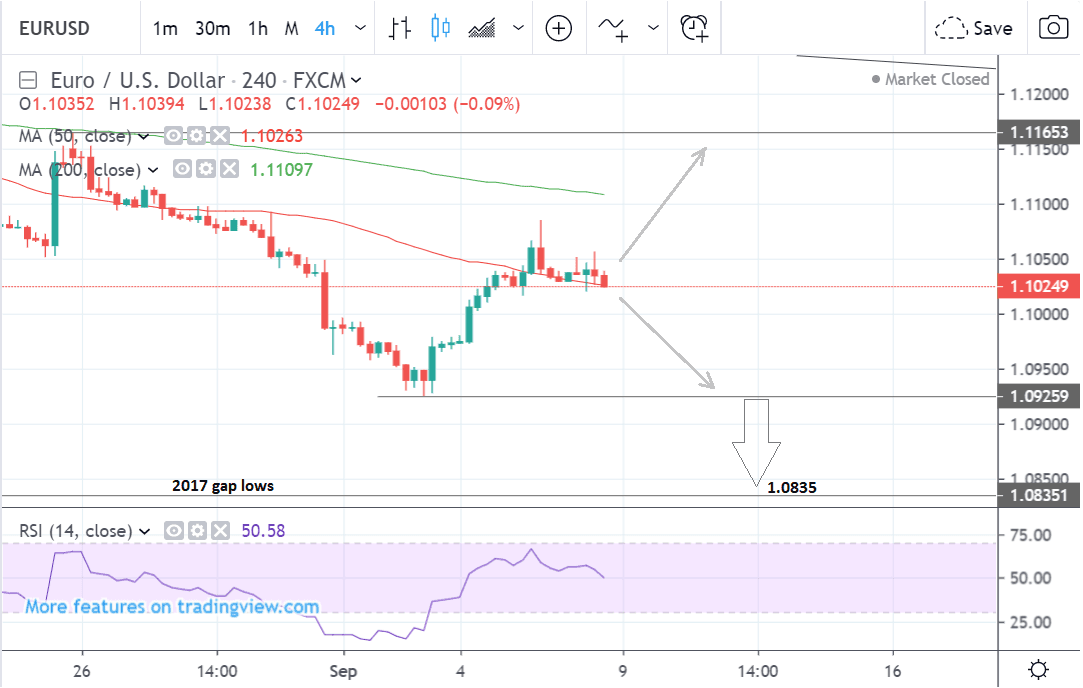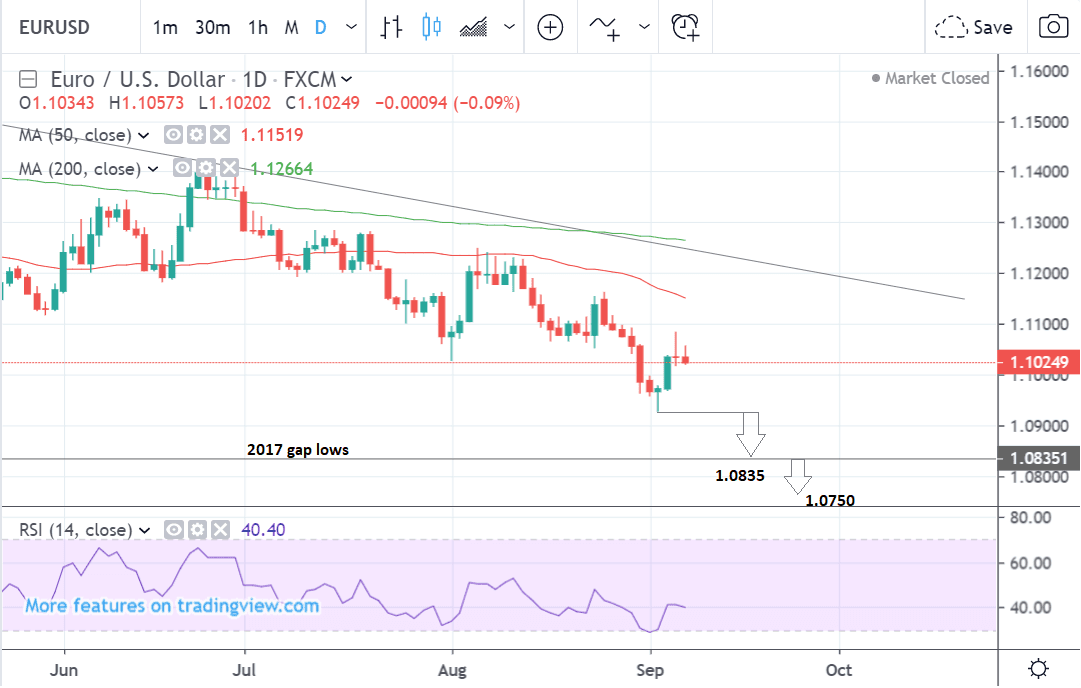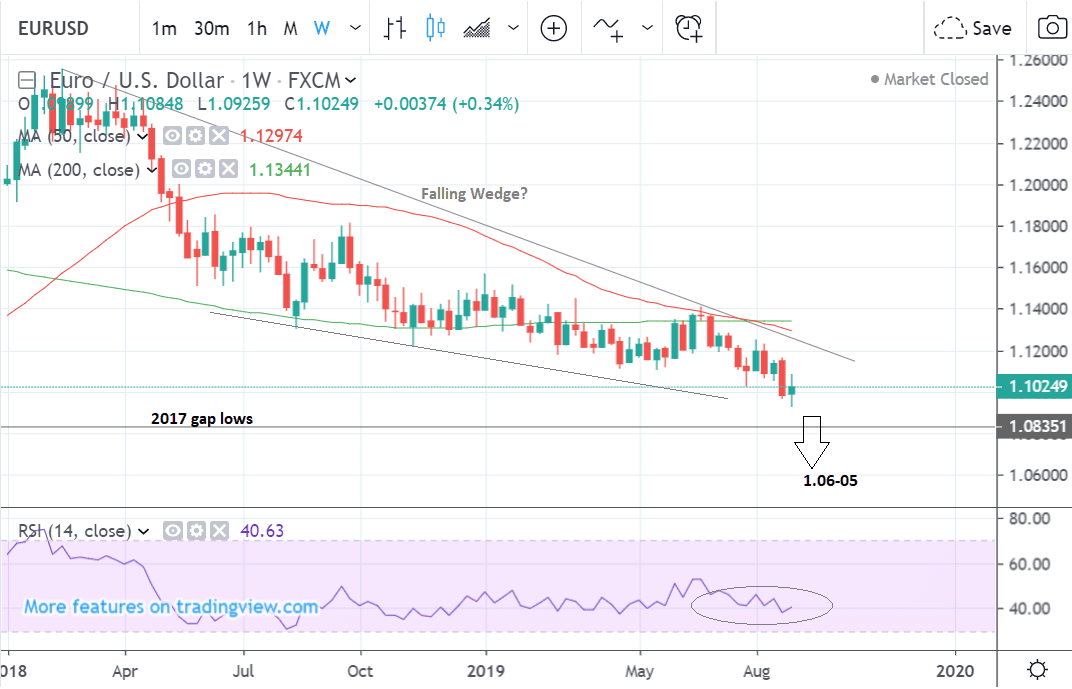EUR/USD Week Ahead Forecast: Downtrend Remains Intact, Key ECB Decision to Provide Volatility

Above: The ECB's Draghi is in focus Thursday. File image © European Central Bank
- EUR/USD 's downtrend to probably continue
- Bullish risk factors longer-term
- Euro to be moved by ECB meeting; U.S. Dollar by CPI and retail sales
The Euro-to-Dollar rate is trading at around 1.1024 at the start of what promises to be a busy week for the pair owing to a crucial decision at the European Central Bank. While the ECB should provide volatility on Thursday, our technical studies of the charts are showing the short-term trend remains bearish and likely to extend.
The 4 hour chart - used to determine the short-term outlook, which includes the coming week or next 5 days - shows the pair has rebounded after reaching new multi year lows of 1.0926, however, the rebound is insufficient to signal a reversal and the downtrend remains intact.
Given the principle that the established trend is more likely to extend than reverse, the short-term downtrend will probably continue lower.
A move down to the prior lows in the 1.09s is quite possible. A break below them would see the pair decline further, to a target at 1.0835, a key level where a market gap occurred during the rapid decline in April 2017.
Market gaps often provide levels of future support and resistance to the market.
A less likely but still possible scenario is that the pair continues to recover up to a target at 1.1165 and the August highs.
The daily chart shows the exchange rate in a longer-term established downtrend which is likely to continue.
A break below the September 3 lows at 1.0926 would provide confirmation of more downside to a target at 1.0835, followed by 1.0750 potentially.
The daily chart is used to give us an indication of the outlook for the medium-term, defined as the next week to a month ahead.
The weekly chart also shows the pair in a longer-term downtrend which is likely to continue.
The next set of downside targets are 1.0600 and 1.0500.
The lack of downside momentum as measured by the RSI indicator (circled) makes us cautious of becoming too bearish, and there is an old market saying to ‘never short a dull market’ which warns not to sell if downside momentum is slowing.
Indeed, there is a possibility that the pair may eventually rise since it looks like it may have formed a ‘falling wedge pattern’. Falling wedges eventually break higher, often with force. Whilst it is far from conclusive that this will be the case, it remains a bullish risk factor.
The weekly chart is used to give us an idea of the longer-term outlook, which includes the next few months.
Time to move your money? Get 3-5% more currency than your bank would offer by using the services of foreign exchange specialists at RationalFX. A specialist broker can deliver you an exchange rate closer to the real market rate, thereby saving you substantial quantities of currency. Find out more here.
* Advertisement
The Euro: What to Watch

The main event for the Euro in the week ahead is the European Central Bank (ECB) policy meeting on Thursday, at 12.45 BST.
The ECB is widely expected to ease policy at the meeting in order to help support the ailing Eurozone economy.
A loosening of monetary policy is generally negative for the Euro as it involves either an increase in liquidity - in the case of QE - which dilutes the currency, or a lowering of interest rates, which lowers net foreign capital inflows.
The main debate amongst investors appears to be about whether the ECB will revive its QE programme and whether they will cut interest rates further.
There has been much talk of a 'shock and awe' police response to the Eurozone's recent economic slowdown: the larger the stimulus, the more likely it will boost growth and raise inflation.
“The European Central Bank communicated its intention to take decisive policy action in September well in advance of Thursday’s meeting, fuelling speculation that it is about to unleash another ‘bazooka’ of monetary stimulus," says Raffi Boyadijian, an investment analyst at broker XM.com.
By this measure, the greater the stimulus, the more likely a decline in the Euro.
Analysts at investment bank Wells Fargo expect an aggressive policy move and the ECB to launch a 45bn QE programme, with a -0.1% cut to both the refinancing and the deposit rate.
“Our expectation is that the ECB will cut rates 10 bps and restart its QE program. Specifically, we expect the ECB to buy €45 billion a month in sovereign bonds for the next 12 months. Recent pushback against restarting QE from some ECB officials, however, makes the second portion of this forecast more uncertain than the first,” says Wells Fargo.
However, there is also a chance the ECB will underwhelms, a scenario that would aid Euro gains.
A number of ECB Governing Council members have expressed scepticism this would be a good idea and the GC appears split over the matter.
If QE - also known as the Asset Purchase Programme - is not expanded it might actually lift the Euro marginally as the general expectation is that they will press the button and begin between 15-45bn Euros of asset purchases a month.
If the ECB opts to restart QE they will also almost certainly cut interest rates.
QE tends to depress long-term rates which leads to a flatter yield curve, and that is bad for banks. In order to avoid negative side effects, the ECB will also need to cut short-term rates by cutting its refinancing or lending rate and deposit rate too. These currently stand at 0.0% and -0.4% respectively.
The most benign option would be to do nothing or only cut the deposit rate by -0.1% to -0.5%.
A cut in the deposit rate is probably already priced in by markets.
If the ECB does nothing the Euro will probably make a strong recovery. Much depends on the language of the statement and whether it hints at the likelihood of further cuts or not.
"There’s a risk markets may have gotten ahead of themselves as remarks by ECB officials in recent days have cast doubt on the likelihood of a fresh round of asset purchases,” says Boyadijian. “Should the Bank deliver only a rate cut (a 10-basis points reduction in the deposit rate is almost certain), the decision could be met with disappointment, triggering a sell-off in European stocks while boosting the Euro."
Boyadijian adds that if the ECB’s announcement falls short of expectations, its forward guidance will be just as important, and the market fallout could be minimised if policymakers leave the door open for quantitative easing in the future.
The U.S. Dollar: What to Watch

The two main data releases for the U.S. Dollar in the coming week are inflation data on Thursday and retail sales on Friday.
Inflation data is forecast to show a rise of 0.1% a month in August, and 3.30% a year, when it is released at 13.30 BST on Thursday, September 12.
Core inflation is expected to show a 0.2% rise month-on-month and a 2.3% yearly rise.
Inflation data affects interest rates which impact on the U.S. Dollar. Higher inflation tends to lift interest rates which is positive for the Dollar and vice versa for lower interest rates.
Inflation has been rising quite strongly over recent months but should ease marginally in August according to some analysts.
“Core CPI inflation has ripped higher over the past two months, registering back-to-back gains of 0.3%. The prior two months’ strength was helped by catch-up in apparel and used autos prices, with July getting an extra boost from the volatile hotel and airfare components. We expect to see those effects fade in August, but for core prices to still eke out a 0.2% gain. Including food and energy, we expect the CPI to rise only 0.1% due to lower gas prices last month,” says U.S. lender Wells Fargo in a preview note to clients.
Despite recent strong gains in inflation, analysts at Wells Fargo do not expect the Federal Reserve (Fed) to drop their bias towards easing and cutting interest rates.
“Another surprisingly strong reading on core inflation is unlikely to sway the FOMC’s easing bias. We believe the Fed has grown more tolerant of 2%+ inflation as it desires to raise levels of inflation expectations,” says the bank.
Higher inflation could be a result, in part, to rising tariffs on inports - an influence the Fed is likely to ‘look through’.
Retail sales data is forecast to show a 0.2% monthly rise in August (0.1% for core sales), which is slower than the 0.7% result in July.
The U.S. consumer has remained relatively resilient despite the recent slowdown in manufacturing and the release will provide insight as to whether that is still the case.
“On Friday, retail sales and the University of Michigan’s preliminary reading of the consumer sentiment index will be closely watched too for proof that US consumers are still spending generously. In July, retail sales jumped by a stronger-than-expected 0.7% month-on-month. They’re forecast to have moderated somewhat to 0.3% in August,” says Raffi Bopyadijian, an investment analyst at FX broker XM.com.
The report could be key in relation to the Fed’s assessment of monetary conditions.
“The August retail sales report will be poured over to gauge how consumer spending is faring in the wake of recent tariff threats and volatility in financial markets. Another solid report will be taken by the Fed as a signal that consumer spending is holding up in the face of global headwinds, and that the economy is not in much need of additional policy accommodation at this time. A big miss, however, would raise concerns that consumer spending cannot sufficiently offset the headwinds from slower global growth and trade uncertainty, and add urgency for the Fed to ease policy further,” says Wells Fargo.
Time to move your money? Get 3-5% more currency than your bank would offer by using the services of foreign exchange specialists at RationalFX. A specialist broker can deliver you an exchange rate closer to the real market rate, thereby saving you substantial quantities of currency. Find out more here.
* Advertisement







